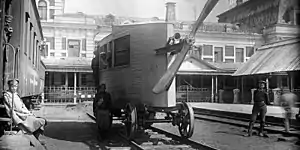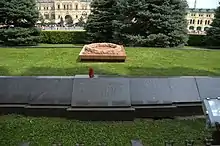Valerian Abakovsky
Valerian Ivanovich Abakovsky (Russian: Валериа́н Ива́нович Абако́вский, Latvian: Valerians Abakovskis; 5 October 1895 – 24 July 1921) was a Soviet engineer who is best remembered as the inventor of the Aerowagon.
Valerian Abakovsky | |
|---|---|
 | |
| Born | 5 October 1895 |
| Died | 24 July 1921 (aged 25) |
| Resting place | Kremlin Wall Necropolis, Moscow |
| Occupation(s) | Inventor, chauffeur |
| Known for | Aerowagon |
Early life
He was born in Riga on October 5, 1895 in to a Russian family. Although a talented inventor, he worked as a chauffeur for the Tambov Cheka.
The Aerowagon
The invention for which Abakovsky is remembered is the Aerowagon, an experimental high-speed railcar fitted with an airplane engine and propeller propulsion. It was originally intended to carry Soviet officials.

Death

On 24 July 1921, a group of communists led by Soviet politician Fyodor Sergeyev took the Aerowagon from Moscow to the Tula collieries to test it. Abakovsky was also on board. Although they successfully arrived in Tula, on the return route to Moscow the Aerowagon derailed at high speed, killing 7 of the 22 on board. The following people died in the accident:
- Ivan Konstantinov, Bulgarian delegate
- Paul Freeman, Australian delegate
- Oskar Helbrich, German delegate
- John William Hewlett, British delegate
- Fyodor Sergeyev (known as "Comrade Artyom")
- Otto Strupat (born 1893), German delegate
- Valerian Abakovsky himself, at the age of 25.
The seven men killed in the crash lay in state at the House of the Unions, after which they were buried in the Kremlin Wall Necropolis. Sergeyev is buried in Mass Grave No. 12, Konstantinov, Abakovsky and Freeman are buried in Mass Grave No. 13, while Strupat, Helbrich and Hewlett are buried in Mass Grave No. 14.
References
- Alexey Abramov / Алексей Абрамов, By the Kremlin Wall / У кремлёвской стены, Moscow / Москва́, Politizdat / Политиздат, 1978, pp./стр. 399 (in Russian)